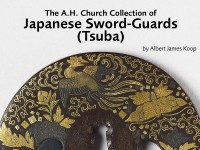The A. H. Church Collection of Japanese Sword-Guards (Tsuba)
An unpublished catalogue of the A. H. Church collection of Japanese sword-guards (tsuba) by Albert James Koop.

Sugiura Jōi (1700-1761), another pupil of the Ko-Nara, initiated, or at least developed to a high pitch of perfection, a new style in figure representation. This is the sunk relief (intaglio rilievato) of very delicate, though forceful modelling, known as shishiai- (or nikuai) bori, “complexion carving”, which imparts great expressiveness to the play of the features and the flowing lines of the draperies. To this is added to a moderate amount of the iroye incrustation or inlay, combined with katakiri engraving. The favourite ground is plain copper, but shibuichi is also used.
Jōi’s signature has been forged on a vast number of bad or indifferent imitations. His nephew, Kawakatsu Jōwa, was his best pupil.
Notice
Object information may not accurately reflect the actual contents of the original publication, since our online objects contain current information held in our collections database. Click on 'buy this publication' to purchase printed versions of our online publications, where available, or contact the Jameel Study Centre to arrange access to books on our collections that are now out of print.
© 2013 University of Oxford - Ashmolean Museum






